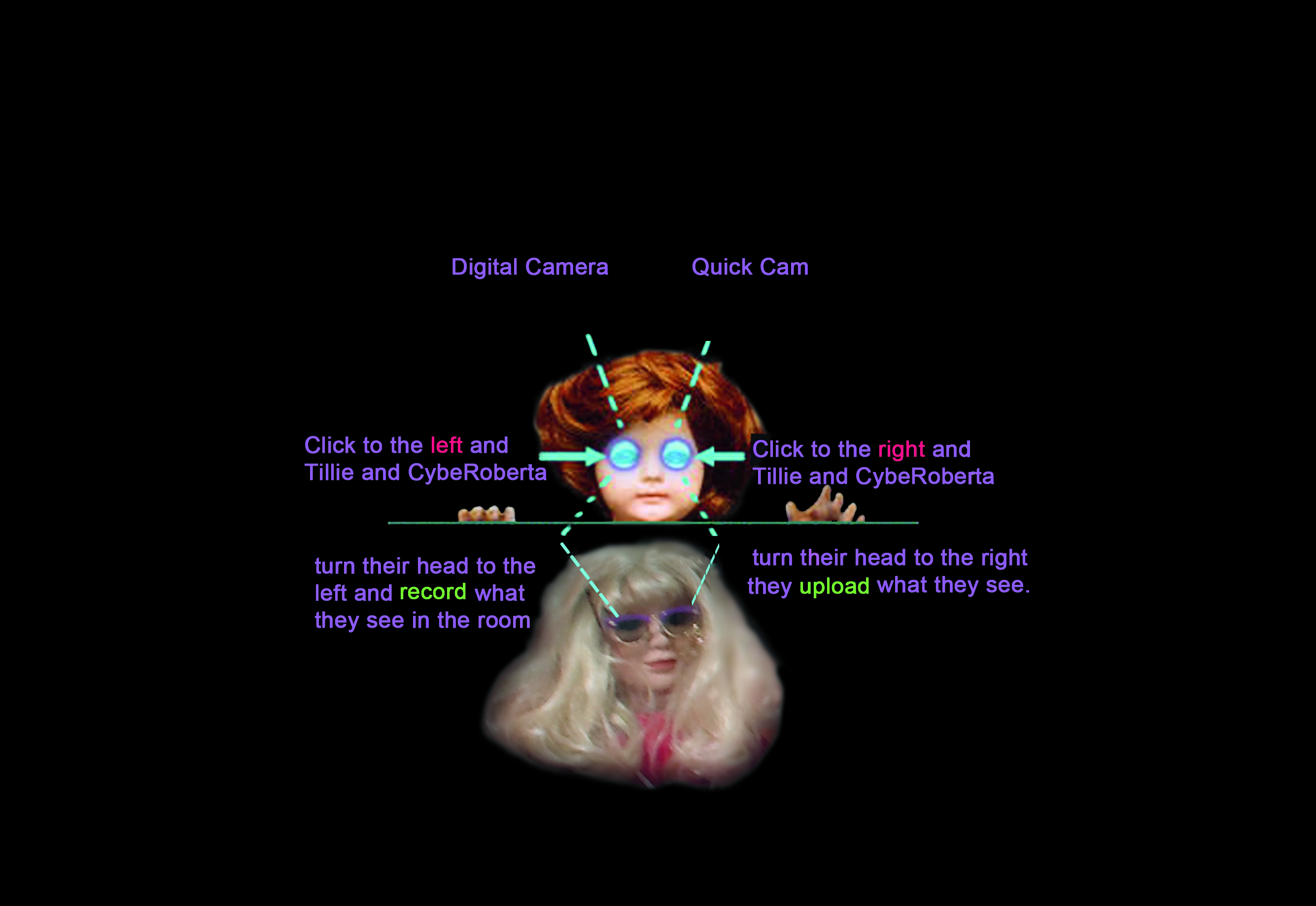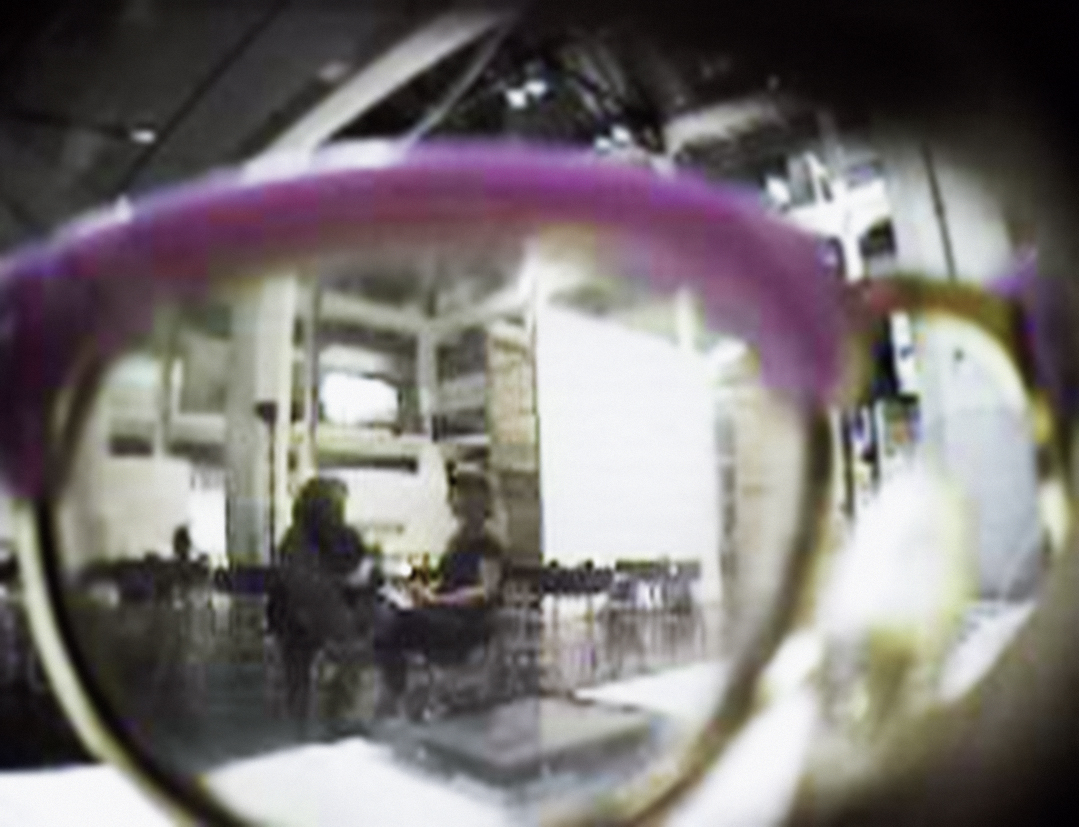This essay accompanies the presentation of Lynn Hershman Leeson's Dollie Clone Series as a part of the online exhibition Net Art Anthology.
Tillie and CybeRoberta, the two telerobotic dolls comprising Lynn Hershman Leeson’s “Dollie Clone Series,” were born in part by failure—namely, by refiguring a stubborn piece of technology that just wouldn’t work. In 1993, Hershman Leeson was commissioned by Zentrum für Kunst und Medien in Karlsruhe, Germany to make an installation in which two telerobotic cameras captured live images inside the institution’s gallery and streamed them online. The piece, titled Difference Engine #3, was inspired by 19th-century inventor and mathematician Charles Babbage’s difference engine, a massive, steam-powered proto-computer designed to calculate polynomial functions. In the mid-1990s, Hershman Leeson was also working on the feature film “Conceiving Ada,” which stars Tilda Swinton as Ada Lovelace, a contemporary of Babbage who is known for conceiving the first computer for the purposes of art. In the film, as in history, Lovelace helps Babbage rewrite the difference engine so that the program could be applied to art, poetry and music, not just toward solving calculations.
Both Babbage and Hershman Leeson had trouble getting their ideas off the ground—Babbage never saw a complete difference engine #1 in his lifetime, but went on to create a functional, simpler difference engine #2—and it took Hershman Leeson over two years to get her ZKM project to work. The prospect of streaming video, before wifi and smart phones existed, was a tall order. “That was Netscape 2.0 in those days. Needless to say it wasn’t very stable,” Hershman Leeson told me in a recent phone call. The piece won the Prix Ars Electronica Golden Nica in 1999, but at its exhibition in Berlin Hershman Leeson couldn’t get it to work, much to the dismay of her German colleagues.
The artist started to think about what else could be done with the technology in another context. “Instead of using these units to look into the museum, I started to think about a doll whose eyes could look around the room and transmit the information to the net, both see what's in the room with one eye and then transmit it to the other eye, and then people at home could use it as a surveillance unit to look around the location that the doll was sitting in. That was how Tillie was born.” Tillie has video cameras implanted into her eyes that produce a real-time stream of her line of sight. One eye uploads a 320×200 pixel black-and-white images to a web feed that refreshes every thirty seconds, and the other streams a color feed to a small monitor shown next to the doll.

Dolls' instruction diagram, 2015 (updated from 1995).
Also influencing the piece is Hershman Leeson’s lasting interest both in cyborgs kept alive and controlled by technology, particularly Fritz Lang’s Frankenstein character Maria from Metropolis (1927), as well as biogenetics and gene editing. The Human Genome Project, an international scientific mission to map—and essentially visualize—human DNA, had launched in 1990, just a few years before the dolls’ first installation. Dolly the sheep had also been cloned in 1996, and as such Hershman Leeson saw fit to make a twin for her “Dollie Clones”—the title of the series. Tillie’s clone, CybeRoberta, is sort of her evil twin, constantly pirating Tillie’s feed. She’s also a spinoff of Hershman Leeson’s long-running performance as her alter-ego, Roberta Breitmore (1973–1979). “When the ‘Dollie Clones’ were born, I thought to convert Roberta, who had been exorcised about five years earlier, and have her re-emerge as this kind of evil twin that would steal the information from Tillie when they were in some proximity,” says Hershman Leeson.
The “Dollie Clone Series” was not explicitly conceived of as a comment on surveillance culture, however. Nanny cams hadn’t been invented yet, and in the mid-1990s the prospect of seeing another vantage, real-time, in a location feet or miles away, was incredibly futuristic. There was something democratic and utopian about the idea of being connected in this way, and the preemptive criticality and suspicion with which we might look at a CCTV unit in an artwork made today didn’t apply at the time. “I didn't even think of it as being a surveillance unit until later—I just wanted to be able to look in the room and turn her head and look around,” says Hershman Leeson. “The word ‘surveillance’ didn't register. It was more like a living thing that brought something on the internet into the present, or something present onto the internet.”

Looking at Lynn Hershman Leeson's 2011 ZKM exhibition through CybeRoberta's eyes.
Regarding failure, Hershman Leeson ultimately found the experience of bungling her Ars Electronica presentation productive. “Tillie and CybeRoberta were born out this frustration in dealing with failure and then taking charge of it. I took it into my own hands and tried to re-figure, literally re-figure her into something manageable that could be simple, and do what the invention was supposed to do in a smaller and more manageable way that I thought was in some sense even more relevant.” Hershman Leeson considers the dolls themselves an invention, specifically a difference engine, and looks at this science with a poetic license. She considers the doll’s vision a stream of information, specifically data. Further suggesting a “datafication” of the dolls’ gaze is the ZKM description for Difference Engine #3, which states, “…the webcam piece calculates the captured image and position in the physical/virtual space of visitors to a physical space. Hershman Leeson thus calls attention to the uncanny relationship between information, streams, and sight—and our propensity as humans to conceptualize and understand things, particularly slippery things like data streams and DNA, through images.
“I wanted Tillie to reference both Ada and Babbage in a more poetic stance using mechanical and technological bodies, and for the viewer to see beyond one's situated presence into a global presence,” says Hershman Leeson. More than just calculating polynomials, Hershman Leeson’s difference engine dolls prompt us to look outside our own lines of vision and into another’s, who could be miles or centuries away.
Header image: CybeRoberta in Lynn Hershman Leeson's studio, 2010.
